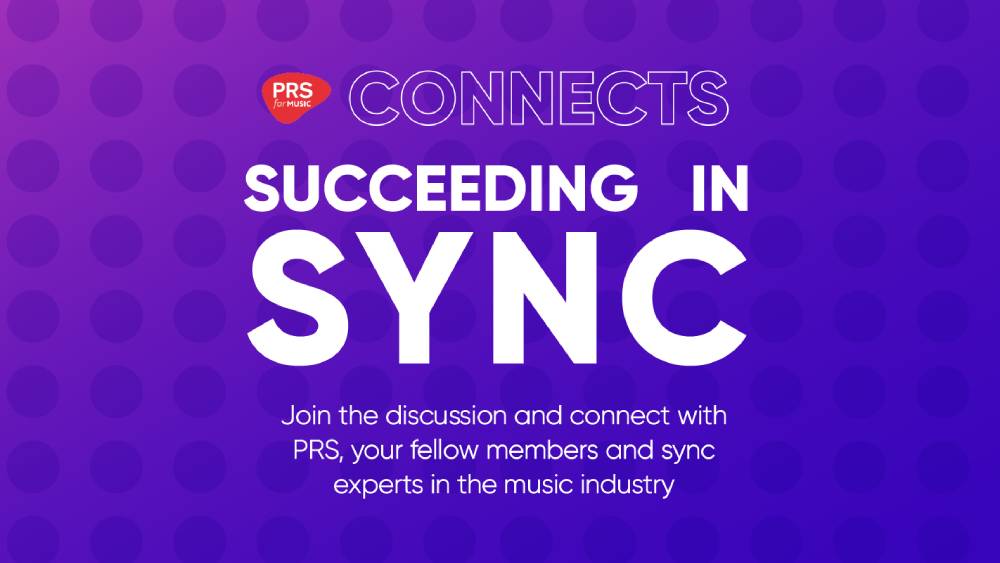For many songwriters, composers and producers, getting their music synced on a film, TV series or national advertising campaign can be a lucrative and career-changing moment. But how exactly does the sync process work?
This question and so much more will be explored in our upcoming PRS Connects session Succeeding in Sync, taking place at OXO2 in central London on 28 March. The event will feature a guest panel of sync experts who will offer valuable information, tips and advice on all things sync, from how to stand out to music supervisors to knowing your rights.
Ahead of Succeeding in Sync, we’ve put together some essential tips to help you get up to speed on sync and make the most of your PRS Connects experience.
Are you a ‘one-stop shop’?
By this, we mean: do you own all the rights to your works and can license them directly, or do you work with a label or a publisher? Are you one of several songwriters on a track? Did you co-produce a song with your collaborators?
Having a clear understanding of who controls the rights to your works is the essential first step in understanding if you're ‘sync-ready’.Music supervisors will need to know if you're signed to a label or if you own the recording rights to your music. Equally, they will need to know if you hold all the performance rights to your music or if you work with a publisher. There’s no preferred scenario, but it's essential for all parties in a sync licensing negotiation to understand who they're contracting with.
This is because there are two different music copyrights involved in every sync placement:
- A Master Use Licence is negotiated for the usage of a sound recording (also known as a ‘master’) and involves the artist or label who owns that studio track or live recording.
- A Sync Licence for the Composition is negotiated for the usage of a song (melody and lyrics), and involves the music publisher, publishing administrator or songwriter(s).
Do you know where your works are?
Having your back catalogue organised with the accurate metadata is an essential part of sync licensing. Are your works all correctly registered with PRS? Log in and check out your registrations online.
You can learn more about the importance of metadata via our Get Paid Guide, while our new and improved Register My Music tool will help you fast-track your work registrations, get organised and up to date.
Are you discoverable?
Is your music available online? Are your social media pages and website updated with links to your music and contact information? Music supervisors are regularly on the hunt for new music, and one of their biggest pet peeves is not being able to reach the artist once they’ve discovered an amazing song.
Be sure to regularly update your bio and contact information across your online pages, including web, social, and DSPs such as Apple Music, Spotify and Amazon Music.
What’s your vibe?
Music supervisors get sent new music all the time from trusted sources, including sync agents, publishers or artist teams, and they are regularly building up their databases.
If you’re sharing your music with a music supervisor, it’s helpful to their workflow to include your music’s genre and sub-genre, as well as groups of keywords such as ‘dreamy, hopeful, optimistic’, or ‘dark, emotional, gritty’. Short descriptors like these can help to assign appropriate music to the briefs that music supervisors receive.
Is your music ‘sync-ready’?
Is your music recorded professionally, or are you working with demos? Do you have instrumental versions? Do you have non-explicit versions? Do you have recording stems to hand? Do you have your tracks ready to share easily and securely?
While music can certainly be selected for a sync when it’s at a demo stage, you are more likely to get synced if your music has been recorded, mixed and mastered to a high standard (in a home or professional studio). Before you leave your studio session, it’s great practice to get your instrumental versions and stems if possible. If your lyrics are explicit, consider having a ‘clean’ version edited or recorded as this can further optimise your sync opportunities.
Do you have a pitch put together?
When approaching a music supervisor, in person or via email, it’s important to be polite, descriptive and concise. Whenever possible, do your research on what that supervisor is currently working on, and only pitch your music if it is genuinely relevant to that project. Briefly introduce yourself, include a short version of your bio, links to listen to your music, your genre(s) and keywords for each track.
Include a handful of your top tracks (rather than your entire discography), and never send links to downloadable files unless you are requested to do so.
Finally – do you know your own brand and values?
While getting a sync placement has become a career goal for many artists, it’s important to have clarity on your own brand and what your boundaries are for your music. You may not want your music to be associated with specific actions on screen, or perhaps you don’t wish to be associated with certain brands.
Having clarity around your brand when you begin your sync journey will save you time and energy.

.ashx?h=67&w=80&la=en&hash=E8662B19DB6CA618F431C4DF6AD51C6B)
